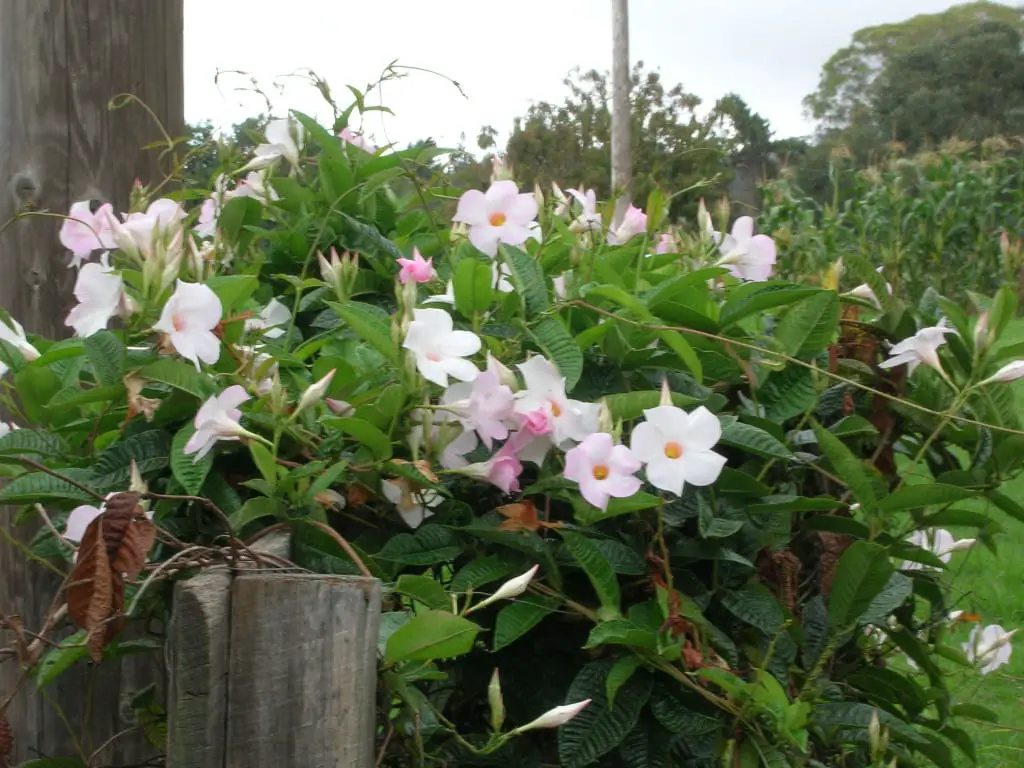Our protagonist today is a climbing shrub with very beautiful flowers, which is popularly known by the names of Chilean jasmine or dipladenia. It is native to South America, specifically from Brazil and Argentina, and it is one of the few climbing plants that grows without problems in a pot, since its height does not exceed three meters. In addition, it is the ideal candidate to cover the grids that we have around the farm, or on the balcony.
Knowing its characteristics and some tricks to keep it healthy is always a good idea, don’t you think? Following I am going to tell you everything you need to know about this beautiful plant so you can enjoy it.
Origin and characteristics of jasmine from Chile
It belongs to the Mandevilla genus, which is made up of about 100 species of native climbers from Central and South America whose maximum height is 6 meters. It is popularly known as mandevilla, dipladenia, Chilean jasmine or Chilean jasmine.
It produces simple leaves, with a sharp tip and entire marginsmore or less clear and bright green. These are perennial (that is, they do not fall in autumn, but rather they fall throughout the year as new ones emerge).
Their flowerswhich give off a very pleasant aroma, sprout in late spring or early summer. They are trumpet-shaped, and can be white, pink, or red.
What is the care of Chilean jasmine?
Location
Chilean jasmine can live outside year-round in warm frost-free climatesbut it can also be indoors in a room where there is a lot of natural light, and is protected from direct sun, since otherwise its leaves could burn.
It is sensitive to cold and especially to excess water.
Earth
- Flower pot: for it to grow healthy, it must be provided with a substrate based on river sand and peat.
- the garden: the land must be fertile, and have good drainage. As the plant is relatively small, if the garden soil you have tends to compact easily, make a hole of about 50cm x 50cm and fill it with the mixture of substrates mentioned above.
Irrigation
You need frequent wateringsbut it is necessary to avoid watering in excess because otherwise the roots would rot. When in doubt, check the moisture in the soil, for example with a thin wooden stick. If when you extract it, it comes out with a lot of soil attached, do not water.
Other ways to know when to water is by picking up the pot once it has been watered and again after a few days. Over time you will know, just with this gesture, when the earth is dry, when it begins to be, and when it is not necessary to water yet.
Anyway, to give you an idea, during the summer, if it is very hot and dry, it may be necessary to water about 3 times a week or even 4. The rest of the year instead with 1 or 2 weekly waterings, depending on the rainfall and the weather, it will be enough.
Subscriber
So that it grows well it is advisable to pay it every fifteen days during the growing and flowering seasonwith guano (for sale here!) or a fertilizer that stimulates flowering (for sale here!) following the instructions specified on the package.
Multiplication
Chilean jasmine multiplies by seeds in spring and by woody cuttings in spring-summer:
Seeds
To achieve a higher probability of success, I advise sowing a maximum of two seeds in each of the alveoli of a seedling traywhich must be filled with substrate for seedlings (for sale here!) or with universal substrate (for sale here!).
Keeping the seedbed moist but not flooded, in semi-shade, they will germinate in about 20 days.
Cuttings
If you prefer, you can multiply your dipladenia by cutting a piece of semi-woody woodimpregnating the base with rooting hormones (for sale here!) and finally planting it in a pot with vermiculite (for sale here!) previously moistened with water and placing the pot in semi-shade.
Thus, if all goes well, it will emit its own roots after about two or three weeks.
How to prune dipladenia?
To make it thicker and more compact, feel free to remove the newest leaves from all the stems or even to trim them a bit in late winter. This will force it to take out new lower stems, obtaining a much more attractive and spectacular Chilean jasmine, like the one you can see in the photo above, full of open and about to open flowers.
Plagues and diseases
Its main enemies are the cochineal and Red spider. Both pests must be controlled with specific insecticides, or prevented by spraying the plant with Neem oil twice a month, or with diatomaceous earth.

Related article:
Prevent your plants from pests with Neem Oil
Planting or transplanting time
In springwhen the minimum temperature is higher than 15ºC.
If you have it in a pot, transfer it to a larger one every 3 years.
Rusticity
Does not resist frost. Maybe up to -2ºC as long as it is sheltered, but it is better not to take risks.
When living in an area with cold winters, the ideal is to keep it either in a greenhouse or indoors until spring returns.
Enjoy your Chilean jasmine!






